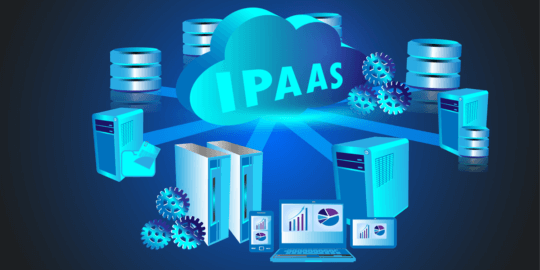What is iPaaS? – An Overview

Definition and SEEBURGER-Solution
iPaaS, or Integration-Platform-as-a-Service, is currently the most frequently used keyword when it comes to the implementation of integration requirements. But what exactly is iPaaS?
iPaaS solves the challenges of self-service operation of a hybrid integration platformThe in-house operation of an integration platform is complex. Procedures and competencies, systems, data and processes must be technically and semantically integrated and operated reliably and securely in their entirety. The integration scene has coined the term Hybrid Integration Platform (HIP) for this purpose. The essence of a HIP is that it can centrally perform all integration requirements in the company. |
A HIP is part of the critical infrastructure, and its smooth operation is crucial to the future of a business. It must be operated at maximum performance and availability with the minimum number of short maintenance windows. A well-known international IT company has summed this mantra up succinctly: ‘Never slow – never down!’ This is a high standard to meet, which is presenting many companies with major technical and commercial challenges – especially when it comes to operating a HIP in-house.
The Benefits of iPaaS
But what does all this have to do with iPaaS? For many companies, the task of operating a hybrid integration platform completely on their own is too complex. This is where a professional cloud provider comes in. The idea behind it is basically quite simple:
| The integration platform is moved to the cloud, where it is implemented and maintained by an external provider. If it is supplemented with connectors for connecting to the increasingly popular cloud services/software-as-a-service applications (SaaS), a complete iPaaS solution is created. |
iPaaS enables companies to host their full integration in the cloud, where it is accessible via an Internet application. No dedicated hardware or middleware needs to be installed and managed for integration. Therefore, iPaaS is often referred to as ‘middleware-as-a-service’. As a cloud-based platform, iPaaS combines data and application integration and, if required, links different cloud models into a hybrid cloud model. In this way, iPaaS fulfils its primary requirement, which is to provide a clean and uniform platform for the integration and thus use of various cloud services.
The advantages of iPaaS are obvious:
Companies book an iPaaS cloud service and have the flexibility to decide how much they want to be involved and what they delegate to the platform provider. This frees them from many burdensome obligations, such as operating:
- a computer center infrastructure
- an operating system
- a database
- a communication infrastructure
and the partly high expenses for:
- surveillance
- troubleshooting
- execution of release upgrades
This leaves companies more time for higher priority tasks.

When does using iPaaS make sense?
iPaaS is the preferred operating model for companies that want to keep the reins in their own hands so that they can develop processes, mappings and configurations themselves, while relieving their own team of time-consuming technical tasks. The cloud provider covers critical issues such as security, data protection and operation. This allows companies to use their existing know-how with the greatest efficiency.
An iPaaS solution is therefore always useful when companies like to use their own know-how while retaining maximum flexibility and independence. For example, a specific integration task could be solved using a standardized cloud service from a third-party provider in the public cloud, i.e. as Software-as-a-Service (SaaS), which is particularly useful for highly standardized application scenarios. Typical examples of this are electronic invoicing in an international environment (Global E-Invoicing Service) or the reporting of internationally traded goods to national customs authorities (EDI Service for SAP GTS), both of which must comply with the respective national legal requirements. An iPaaS provider may therefore have to meet these requirements.
Deployment models for iPaaS
iPaaS can be combined with other operating models, e.g. for the parallel use of SaaS to solve a specific integration task, as just described. The combination of iPaaS with a HIP operated by the company itself is also feasible. In this case, it must be clarified in detail which tasks will be performed by which platform. Typically, iPaaS is responsible for connecting all vendor clouds. Application Programming Interfaces (APIs) play a central role here. They form the interfaces to the various cloud services and should be part of every iPaaS solution.
Some providers also take over all integration tasks in the form of a full-service offer in the public cloud. In a hybrid model, each integration task is deployed where it is most beneficial.
The SEEBURGER iPaaS-Solution
The SEEBURGER iPaaS solution is based on the proven SEEBURGER Business Integration Suite (BIS). This offers investment protection to the customer, as they can ‘re-integrate’ integration tasks that are outsourced to a SEEBURGER iPaaS solution at any time with moderate effort, by switching to a self-operated BIS integration platform. The BIS integration platform on which the iPaaS solution is based combines all protocols, formats and technologies required in the B2B environment in a single product.
The technologically complex operation of the SEEBURGER iPaaS solution is handled by SEEBURGER, whilst the actual integration tasks are performed by the customer. In an initial workshop, the distribution of tasks for iPaaS productive operation is defined in detail. Additional SEEBURGER SaaS services, such as those mentioned above, can be used at any time and connected to a SEEBURGER iPaaS solution. In addition, SEEBURGER provides expert personnel as required.
The core requirements for an iPaaS solution such as:
- implementation of all integration requirements with one tool
- central monitoring
- safe and highly available operation
are fully met. This allows very complex, business critical and extensive integration requirements to be realized. By using a central integration platform, costs can be calculated over the entire life cycle of an integration task.

Thank you for your message
We appreciate your interest in SEEBURGER
Get in contact with us:
Please enter details about your project in the message section so we can direct your inquiry to the right consultant.
Written by: Holger Fiederling
Holger Fiederling has been working for SEEBURGER since 2008 and initially worked as a product manager for SEEBURGER B2B-Solutions. Since 2014, he has been responsible for pre-sales and business development for the SEEBURGER Cloud. His focus is on the creation of new, innovative solutions and services, which are oriented towards the requirements of the customers, always with the aim of maximizing the latest opportunities for the customers. In doing so, he attaches great importance to taking into account the experience gained from all of his international customer projects. After starting his career in the automotive industry, Holger Fiederling worked for two large management consultancies in the SAP environment and in the area of hosting and outsourcing of IT processes. To compensate for this, he spends a lot of time on his mountain bike or skiing in winter.





